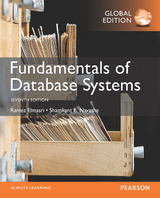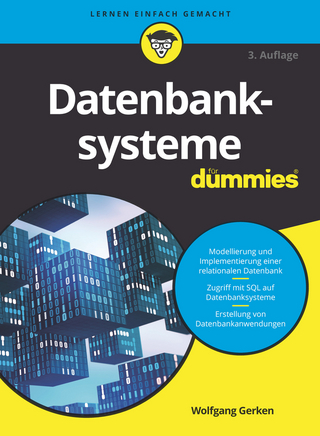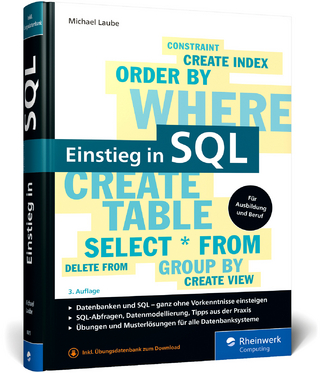
Fundamentals of Database Systems: Pearson New International Edition
Pearson Education Limited (Verlag)
978-1-292-02560-5 (ISBN)
- Titel erscheint in neuer Auflage
- Artikel merken
A lab manual and problems give students opportunities to practice the fundamentals of design and implementation. Real-world examples serve as engaging, practical illustrations of database concepts. The Sixth Edition maintains its coverage of the most popular database topics, including SQL, security, and data mining, and features increased emphasis on XML and semi-structured data.
Part 1: Introduction to Databases
Chapter 1 Databases and Database Users 3
1.1 Introduction 4 1.2 An Example 6
1.3 Characteristics of the Database Approach 9
1.4 Actors on the Scene 14
1.5 Workers behind the Scene 16
1.6 Advantages of Using the DBMS Approach 17
1.7 A Brief History of Database Applications 23
1.8 When Not to Use a DBMS 26
1.9 Summary 27
Review Questions 27
Exercises 28
Selected Bibliography 28
Chapter 2 Database System Concepts and Architecture 29
2.1 Data Models, Schemas, and Instances 30
2.2 Three-Schema Architecture and Data Independence 33
2.3 Database Languages and Interfaces 36
2.4 The Database System Environment 40
2.5 Centralized and Client/Server Architectures for DBMSs 44
2.6 Classification of Database Management Systems 49
2.7 Summary 52
Review Questions 53
Exercises 54
Selected Bibliography 55
Part 2: Relational Data Model and SQL
Chapter 3 The Relational Data Model and Relational Database Constraints 59
3.1 Relational Model Concepts 60
3.2 Relational Model Constraints and Relational Database Schemas 67
3.3 Update Operations, Transactions, and Dealing with Constraint Violations 75
3.4 Summary 79
Review Questions 80
Exercises 80
Selected Bibliography 85
Chapter 4 Basic SQL 87
4.1 SQL Data Definition and Data Types 89
4.2 Specifying Constraints in SQL 94
4.3 Basic Retrieval Queries in SQL 97
4.4 INSERT, DELETE, and UPDATE Statements in SQL 107
4.5 Additional Features of SQL 110
4.6 Summary 111
Review Questions 112
Exercises 112
Selected Bibliography 114
Chapter 5 More SQL: Complex Queries, Triggers, Views, and Schema Modification 115
5.1 More Complex SQL Retrieval Queries 115
5.2 Specifying Constraints as Assertions and Actions as Triggers 131
5.3 Views (Virtual Tables) in SQL 133
5.4 Schema Change Statements in SQL 137
5.5 Summary 139
Review Questions 141
Exercises 141
Selected Bibliography 143
Chapter 6 The Relational Algebra and Relational Calculus 145
6.1 Unary Relational Operations: SELECT and PROJECT 147
6.2 Relational Algebra Operations from Set Theory 152
6.3 Binary Relational Operations: JOIN and DIVISION 157
6.4 Additional Relational Operations 165
6.5 Examples of Queries in Relational Algebra 171
6.6 The Tuple Relational Calculus 174
6.7 The Domain Relational Calculus 183
6.8 Summary 185
Review Questions 186
Exercises 187
Laboratory Exercises 192
Selected Bibliography 194
Part 3: Conceptual Modeling and Database Design
Chapter 7 Data Modeling Using the Entity-Relationship (ER) Model 199
7.1 Using High-Level Conceptual Data Models for Database Design 200
7.2 A Sample Database Application 202
7.3 Entity Types, Entity Sets, Attributes, and Keys 203
7.4 Relationship Types, Relationship Sets, Roles, and Structural Constraints 212
7.5 Weak Entity Types 219
7.6 Refining the ER Design for the COMPANY Database 220
7.7 ER Diagrams, Naming Conventions, and Design Issues 221
7.8 Example of Other Notation: UML Class Diagrams 226
7.9 Relationship Types of Degree Higher than Two 228
7.10 Summary 232
Review Questions 234
Exercises 234
Laboratory Exercises 241
Selected Bibliography 243
Chapter 8 The Enhanced Entity-Relationship (EER) Model 245
8.1 Subclasses, Superclasses, and Inheritance 246
8.2 Specialization and Generalization 248
8.3 Constraints and Characteristics of Specialization and Generalization Hierarchies 251
8.4 Modeling of UNION Types Using Categories 258
8.5 A Sample UNIVERSITY EER Schema, Design Choices, and Formal Definitions 260
8.6 Example of Other Notation: Representing Specialization and Generalization in UML Class Diagrams 265
8.7 Data Abstraction, Knowledge Representation, and Ontology Concepts 267
8.8 Summary 273
Review Questions 273
Exercises 274
Laboratory Exercises 281
Selected Bibliography 284
Chapter 9 Relational Database Design by ERand EER-to-Relational Mapping 285
9.1 Relational Database Design Using ER-to-Relational Mapping 286
9.2 Mapping EER Model Constructs to Relations 294
9.3 Summary 299
Review Questions 299
Exercises 299
Laboratory Exercises 301
Selected Bibliography 302
Chapter 10 Practical Database Design Methodology and Use of UML Diagrams 303
10.1 The Role of Information Systems in Organizations 304
10.2 The Database Design and Implementation Process 309
10.3 Use of UML Diagrams as an Aid to Database Design Specification 328
10.4 Rational Rose: A UML-Based Design Tool 337
10.5 Automated Database Design Tools 342
10.6 Summary 345
Review Questions 347
Selected Bibliography 348
Part 4: Object, Object-Relational, and XML Models
Chapter 11 Object and Object-Relational Databases 353
11.1 Overview of Object Database Concepts 355
11.2 Object-Relational Features: Object Database Extensions to SQL 369
11.3 The ODMG Object Model and the Object Definition Language ODL 376
11.4 Object Database Conceptual Design 395
11.5 The Object Query Language OQL 398
11.6 Overview of the C++ Language Binding in the ODMG Standard 407
11.7 Summary 408
Review Questions 409
Exercises 411
Selected Bibliography 412
Chapter 12 XML: Extensible Markup Language 415
12.1 Structured, Semistructured, and Unstructured Data 416
12.2 XML Hierarchical (Tree) Data Model 420
12.3 XML Documents, DTD, and XML Schema 423
12.4 Storing and Extracting XML Documents from Databases 431
12.5 XML Languages 432
12.6 Extracting XML Documents from Relational Databases 436
12.7 Summary 442
Review Questions 442
Exercises 443
Selected Bibliography 443
Part 5: Database Programming Techniques
Chapter 13 Introduction to SQL Programming Techniques 447
13.1 Database Programming: Techniques and Issues 448
13.2 Embedded SQL, Dynamic SQL, and SQLJ 451
13.3 Database Programming with Function Calls: SQL/CLI and JDBC 464
13.4 Database Stored Procedures and SQL/PSM 473
13.5 Comparing the Three Approaches 476
13.6 Summary 477
Review Questions 478
Exercises 478
Selected Bibliography 479
Chapter 14 Web Database Programming Using PHP 481
14.1 A Simple PHP Example 482
14.2 Overview of Basic Features of PHP 484
14.3 Overview of PHP Database Programming 491
14.4 Summary 496
Review Questions 496
Exercises 497
Selected Bibliography 497
Part 6: Database Normalization Theory
Chapter 15 Basics of Functional Dependencies and Normalization for Relational Databases 501
15.1 Informal Design Guidelines for Relation Schemas 503
15.2 Functional Dependencies 513
15.3 Normal Forms Based on Primary Keys 516
15.4 General Definitions of Second and Third Normal Forms 525
15.5 Boyce-Codd Normal Form 529
15.6 Multivalued Dependency and Fourth Normal Form 531
15.7 Join Dependencies and Fifth Normal Form 534
15.8 Summary 535
Review Questions 536
Exercises 537
Laboratory Exercises 542
Selected Bibliography 542
Chapter 16 Relational Database Design Algorithms and Further Dependencies 543
16.1 Further Topics in Functional Dependencies: Inference Rules, Equivalence, and Minimal Cover 545
16.2 Properties of Relational Decompositions 551
16.3 Algorithms for Relational Database Schema Design 557
16.4 About Nulls, Dangling Tuples, and Alternative Relational Designs 563
16.5 Further Discussion of Multivalued Dependencies and 4NF 567
16.6 Other Dependencies and Normal Forms 571
16.7 Summary 575
Review Questions 576
Exercises 576
Laboratory Exercises 578
Selected Bibliography 579
Part 7: File Structures, Indexing, and Hashing
Chapter 17 Disk Storage, Basic File Structures, and Hashing 583
17.1 Introduction 584
17.2 Secondary Storage Devices 587
17.3 Buffering of Blocks 593
17.4 Placing File Records on Disk 594
17.5 Operations on Files 599
17.6 Files of Unordered Records (Heap Files) 601
17.7 Files of Ordered Records (Sorted Files) 603
17.8 Hashing Techniques 606
17.9 Other Primary File Organizations 616
17.10 Parallelizing Disk Access Using RAID Technology 617
17.11 New Storage Systems 621
17.12 Summary 624
Review Questions 625
Exercises 626
Selected Bibliography 630
Chapter 18 Indexing Structures for Files 631
18.1 Types of Single-Level Ordered Indexes 632
18.2 Multilevel Indexes 643
18.3 Dynamic Multilevel Indexes Using B-Trees and B+-Trees 646
18.4 Indexes on Multiple Keys 660
18.5 Other Types of Indexes 663
18.6 Some General Issues Concerning Indexing 668
18.7 Summary 670
Review Questions 671
Exercises 672
Selected Bibliography 674
Part 8: Query Processing, Optimization, and Database Tuning
Chapter 19 Algorithms for Query Processing and Optimization 679
19.1 Translating SQL Queries into Relational Algebra 681
19.2 Algorithms for External Sorting 682
19.3 Algorithms for SELECT and JOIN Operations 685
19.4 Algorithms for PROJECT and Set Operations 696
19.5 Implementing Aggregate Operations and OUTER JOINs 698
19.6 Combining Operations Using Pipelining 700
19.7 Using Heuristics in Query Optimization 700
19.8 Using Selectivity and Cost Estimates in Query Optimization 710
19.9 Overview of Query Optimization in Oracle 721
19.10 Semantic Query Optimization 722
19.11 Summary 723
Review Questions 723
Exercises 724
Selected Bibliography 725
Chapter 20 Physical Database Design and Tuning 727
20.1 Physical Database Design in Relational Databases 727
20.2 An Overview of Database Tuning in Relational Systems 733
20.3 Summary 739
Review Questions 739
Selected Bibliography 740
Part 9: Transaction Processing, Concurrency Control, and Recovery
Chapter 21 Introduction to Transaction Processing Concepts and Theory 743
21.1 Introduction to Transaction Processing 744
21.2 Transaction and System Concepts 751
21.3 Desirable Properties of Transactions 754
21.4 Characterizing Schedules Based on Recoverability 755
21.5 Characterizing Schedules Based on Serializability 759
21.6 Transaction Support in SQL 770
21.7 Summary 772
Review Questions 772
Exercises 773
Selected Bibliography 775
Chapter 22 Concurrency Control Techniques 777
22.1 Two-Phase Locking Techniques for Concurrency Control 778
22.2 Concurrency Control Based on Timestamp Ordering 788
22.3 Multiversion Concurrency Control Techniques 791
22.4 Validation (Optimistic) Concurrency Control Techniques 794
22.5 Granularity of Data Items and Multiple Granularity Locking 795
22.6 Using Locks for Concurrency Control in Indexes 798
22.7 Other Concurrency Control Issues 800
22.8 Summary 802
Review Questions 803
Exercises 804
Selected Bibliography 804
Chapter 23 Database Recovery Techniques 807
23.1 Recovery Concepts 808
23.2 NO-UNDO/REDO Recovery Based on Deferred Update 815
23.3 Recovery Techniques Based on Immediate Update 817
23.4 Shadow Paging 820
23.5 The ARIES Recovery Algorithm 821
23.6 Recovery in Multidatabase Systems 825
23.7 Database Backup and Recovery from Catastrophic Failures 826
23.8 Summary 827
Review Questions 828
Exercises 829
Selected Bibliography 832
Part 10: Additional Database Topics: Security and Distribution
Chapter 24 Database Security 835
24.1 Introduction to Database Security Issues 836
24.2 Discretionary Access Control Based on Granting and Revoking Privileges 842
24.3 Mandatory Access Control and Role-Based Access Control for Multilevel Security 847
24.4 SQL Injection 855
24.5 Introduction to Statistical Database Security 859
24.6 Introduction to Flow Control 860
24.7 Encryption and Public Key Infrastructures 862
24.8 Privacy Issues and Preservation 866
24.9 Challenges of Database Security 867
24.10 Oracle Label-Based Security 868
24.11 Summary 870
Review Questions 872
Exercises 873
Selected Bibliography 874
Chapter 25 Distributed Databases 877
25.1 Distributed Database Concepts 878
25.2 Types of Distributed Database Systems 883
25.3 Distributed Database Architectures 887
25.4 Data Fragmentation, Replication, and Allocation Techniques for Distributed Database Design 894
25.5 Query Processing and Optimization in Distributed Databases 901
25.6 Overview of Transaction Management in Distributed Databases 907
25.7 Overview of Concurrency Control and Recovery in Distributed Databases 909
25.8 Distributed Catalog Management 913
25.9 Current Trends in Distributed Databases 914
25.10 Distributed Databases in Oracle 915
25.11 Summary 919
Review Questions 921
Exercises 922
Selected Bibliography 924
Part 11: Advanced Database Models, Systems, and Applications
Chapter 26 Enhanced Data Models for Advanced Applications 931
26.1 Active Database Concepts and Triggers 933
26.2 Temporal Database Concepts 943
26.3 Spatial Database Concepts 957
26.4 Multimedia Database Concepts 965
26.5 Introduction to Deductive Databases 970
26.6 Summary 983
Review Questions 985
Exercises 986
Selected Bibliography 989
Chapter 27 Introduction to Information Retrieval and Web Search 993
27.1 Information Retrieval (IR) Concepts 994
27.2 Retrieval Models 1001
27.3 Types of Queries in IR Systems 1007
27.4 Text Preprocessing 1009
27.5 Inverted Indexing 1012
27.6 Evaluation Measures of Search Relevance 1014
27.7 Web Search and Analysis 1018
27.8 Trends in Information Retrieval 1028
27.9 Summary 1030
Review Questions 1031
Selected Bibliography 1033
Chapter 28 Overview of Data Warehousing and OLAP 1067
28.1 Introduction, Definitions, and Terminology 1067
28.2 Characteristics of Data Warehouses 1069
28.3 Data Modeling for Data Warehouses 1070
28.4 Building a Data Warehouse 1075
28.5 Typical Functionality of a Data Warehouse 1078
28.6 Data Warehouse versus Views 1079
28.7 Difficulties of Implementing Data Warehouses 1080
28.8 Summary 1081
Review Questions 1081
Selected Bibliography 1082
Appendix A Alternative Diagrammatic Notations for ER Models 1083
Appendix B Parameters of Disks 1087
Appendix C Overview of the QBE Language 1091
C.1 Basic Retrievals in QBE 1091
C.2 Grouping, Aggregation, and Database Modification in QBE 1095
Appendix D Overview of the Hierarchical Data Model (located on the Companion Website at http://www.pearsonhighered.com/elmasri)
Appendix E Overview of the Network Data Model (located on the Companion Website at http://www.pearsonhighered.com/elmasri)
Selected Bibliography 1099
Index 1133
*An access code for the Companion Website is included with each new textbook purchase of Fundamentals of Database Systems, 6/e
| Verlagsort | Harlow |
|---|---|
| Sprache | englisch |
| Maße | 220 x 275 mm |
| Gewicht | 2288 g |
| Themenwelt | Mathematik / Informatik ► Informatik ► Datenbanken |
| ISBN-10 | 1-292-02560-3 / 1292025603 |
| ISBN-13 | 978-1-292-02560-5 / 9781292025605 |
| Zustand | Neuware |
| Haben Sie eine Frage zum Produkt? |
aus dem Bereich



